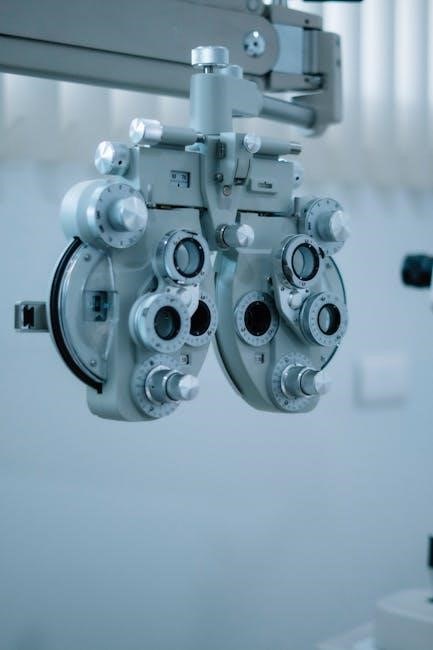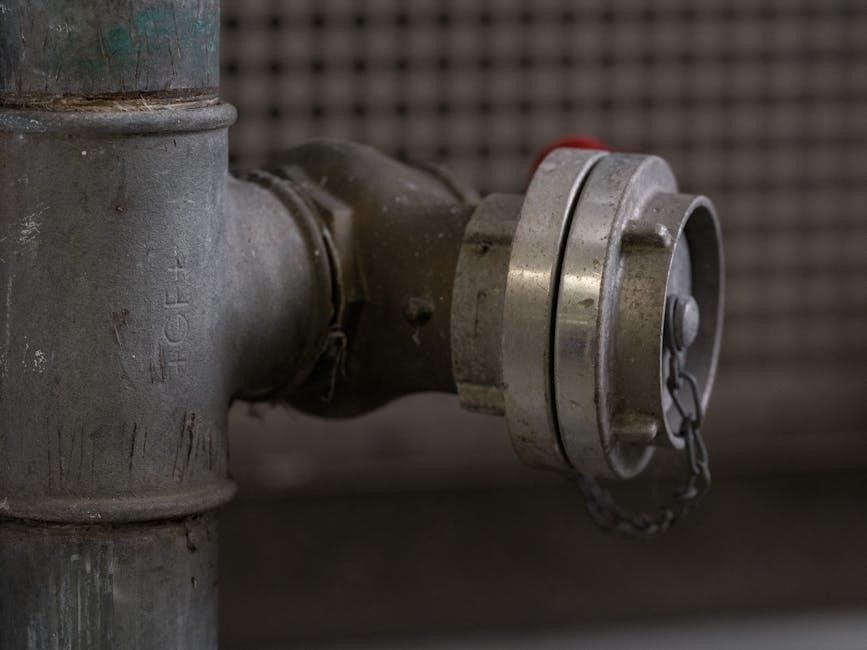The 6.7 Cummins valve adjustment is a critical maintenance procedure, ensuring optimal engine performance and efficiency. Though designed for low maintenance, regular checks are essential. The process is straightforward with proper tools but requires adherence to guidelines for accurate results and to prevent mechanical issues.
1.1 Importance of Valve Adjustment for Engine Performance
Proper valve adjustment is critical for optimal engine performance in the 6.7 Cummins. Correct valve lash ensures precise airflow and combustion, directly impacting power, efficiency, and reliability. Incorrect clearance can lead to reduced power, poor fuel efficiency, and increased emissions. Over time, improper adjustment can cause mechanical stress, leading to premature wear on valves and related components. Regular adjustments prevent these issues, ensuring smooth engine operation and minimizing the risk of costly repairs. Accurate valve adjustment is essential for maintaining peak performance, efficiency, and longevity of the 6.7 Cummins engine.
1.2 Overview of the 6.7 Cummins Engine Valve System
The 6.7 Cummins engine features a robust overhead valve (OHV) design with four valves per cylinder—two intake and two exhaust. This configuration enhances airflow and combustion efficiency, contributing to increased power and fuel efficiency. The valve system includes components like the valve train, rocker arms, pushrods, and hydraulic lifters, which work together to regulate valve operation. The engine also incorporates Variable Valve Event and Lift (VVEL) technology, optimizing valve timing and lift for improved performance across various driving conditions. This advanced system ensures reliable operation and maximizes the engine’s potential for both power and durability;

Preparation for Valve Adjustment
Proper preparation ensures a smooth valve adjustment process. Gather tools, set the engine to TDC, and follow safety guidelines. Wear protective gear and ensure the engine is cool.
2.1 Tools and Equipment Required
Adjusting the valves on a 6.7 Cummins engine requires specific tools to ensure accuracy and safety. Essential tools include a feeler gauge for measuring valve lash, a torque wrench for tightening components to specifications, and a socket set for removing the valve cover and accessing the valves. Additionally, a pair of needle-nose pliers may be needed for adjusting valve lash. Safety gear such as gloves and safety glasses is crucial. A work light can provide better visibility, and a service manual or torque specification chart is recommended for reference. Having shop rags and cleaning solvents on hand is also beneficial.
2.2 Setting the Engine to Top Dead Center (TDC)
Setting the engine to Top Dead Center (TDC) is critical for accurate valve adjustment. Rotate the engine gently using the crankshaft bolt until the timing mark on the crankshaft aligns with the zero mark on the timing cover. This ensures the piston is at the top of its compression stroke. Use a socket wrench or ratchet for this process. Ensure the engine is cold to prevent damage. Once aligned, the intake and exhaust valves for the corresponding cylinder will be in a closed position, allowing for precise measurements and adjustments. Accuracy here is key to maintaining proper engine function.
2.3 Safety Precautions and Best Practices

Always wear protective gear, including gloves and safety goggles, when performing valve adjustments. Ensure the engine is completely cool to avoid burns or injuries. Use jack stands for added safety if working under the vehicle. Disconnect the battery to prevent accidental engine start-up. Keep the work area well-ventilated to avoid inhaling harmful fumes. Follow the manufacturer’s guidelines for torque specifications and adjustment procedures. Double-check all adjustments to prevent costly repairs. Never skip steps or rush the process, as precision is critical for engine performance and longevity.

Valve Adjustment Sequence
Adjust valves in numerical order, starting with cylinder 1 intake, then exhaust, proceeding sequentially to cylinder 5. Use specified tools and torque specifications for accuracy.
3.1 Cylinder 1 Intake and Exhaust Valve Adjustment
Begin with Cylinder 1 by locating the intake and exhaust valves. Rotate the engine to ensure the piston is at TDC. Use a feeler gauge to measure the valve lash, adjusting the intake valve to 0.010″ and the exhaust valve to 0.020″. Tighten the adjusting screws and torque to 18-22 ft-lbs. Repeat the process for accuracy. Ensure proper clearance to avoid engine damage. Always refer to the manufacturer’s torque specifications for precise adjustments. Label completed valves to maintain organization during the process.
3.2 Cylinder 2 Intake and Exhaust Valve Adjustment
Move to Cylinder 2 and locate its intake and exhaust valves. Rotate the engine to TDC for Cylinder 2, ensuring proper alignment. Use a feeler gauge to measure the intake valve lash, adjusting it to 0.010″. For the exhaust valve, set the lash to 0.020″. Tighten the adjusting screws securely and torque them to 18-22 ft-lbs. Double-check measurements to ensure accuracy. Proper clearance prevents engine damage. Label the completed valves to track progress. Follow the same procedure as Cylinder 1 for consistency and reliability. Verify torque specifications to maintain engine performance and durability.
3.3 Cylinder 3 Intake and Exhaust Valve Adjustment
Proceed to Cylinder 3, located on the driver’s side of the engine. Rotate the crankshaft to set Cylinder 3 at TDC, confirming with a compression test if needed. Measure the intake valve lash using a feeler gauge, setting it to 0.010″. For the exhaust valve, adjust to 0.020″. Tighten the adjusting screws and torque to 18-22 ft-lbs. Ensure valves are properly seated and free from noise. Double-check clearances for accuracy. Label Cylinder 3 valves as completed to maintain organization. Follow the same method as previous cylinders for consistency. Proper adjustment ensures optimal engine performance and longevity.
3.4 Cylinder 4 Intake and Exhaust Valve Adjustment
Move to Cylinder 4, located on the driver’s side, adjacent to Cylinder 3. Rotate the crankshaft to position Cylinder 4 at TDC, confirming with a compression test if necessary. Measure the intake valve lash using a feeler gauge, setting it to 0.010″. For the exhaust valve, adjust to 0.020″. Tighten the adjusting screws and torque to 18-22 ft-lbs. Ensure the valves are properly seated and free from noise. Double-check clearances for accuracy. Label Cylinder 4 valves as completed to maintain organization. Follow the same method as previous cylinders for consistency. Proper adjustment ensures optimal engine performance and longevity.
3.5 Cylinder 5 Intake and Exhaust Valve Adjustment
Proceed to Cylinder 5, located on the driver’s side, adjacent to Cylinder 6. Rotate the crankshaft to set Cylinder 5 at TDC, verifying with a compression test if needed. Measure the intake valve lash with a feeler gauge, adjusting to 0.010″. For the exhaust valve, set the lash to 0.020″. Tighten the adjusting screws and torque to 18-22 ft-lbs. Ensure the valves operate smoothly and quietly. Double-check clearances for precision. Mark Cylinder 5 as completed to maintain organization; Follow the same method as previous cylinders to ensure consistency and proper engine function.

Measuring and Adjusting Valve Lash
Use a feeler gauge to measure valve lash, ensuring intake valves are set to 0.010″ and exhaust valves to 0.020″. Adjust as needed, then torque adjustment screws to 18-22 ft-lbs for proper seating and engine performance.
4.1 Using a Feeler Gauge for Accurate Measurements
Using a feeler gauge is essential for accurately measuring the valve lash on your 6.7 Cummins engine. Begin by setting the engine to Top Dead Center (TDC) to ensure the valves are in the correct position for measurement. Once the engine is properly positioned, locate the valve stem and rocker arm. Insert the appropriate feeler gauge between these two components to measure the gap. The recommended specifications for valve lash are typically 0.010″ for intake valves and 0.020″ for exhaust valves. If the gap does not match the specifications, adjustments will be necessary. Always refer to your service manual for precise instructions and to ensure accurate measurements. Proper use of the feeler gauge guarantees that your valve lash adjustments are precise, which is vital for maintaining optimal engine performance and preventing potential damage. After measuring, proceed with any necessary adjustments and torque the adjustment screws as specified to complete the process effectively.
4.2 Adjusting Intake and Exhaust Valves to Specifications
Once the valve lash measurements are taken, adjustments can be made using the feeler gauge results. For intake valves, the specification is typically 0.010″ of clearance, while exhaust valves require 0.020″. To adjust, loosen the adjustment nut slightly and turn the adjustment screw until the desired clearance is achieved. Tighten the adjustment nut firmly to secure the screw in place. Ensure the torque specification for the adjustment nut is met, usually around 20-25 ft-lbs. Repeat this process for all valves, referencing the service manual for precise instructions. Proper adjustment ensures optimal engine performance and prevents damage. Always verify the clearances after tightening to confirm accuracy. This step is critical for maintaining the health and efficiency of your 6.7 Cummins engine.
4.3 Torque Specifications for Valve Adjustment
The torque specifications for the valve adjustment nuts on a 6.7 Cummins engine are critical to ensure proper valve train operation. The adjustment nuts should be torqued to 20-25 ft-lbs using a torque wrench. It’s essential to follow the manufacturer’s guidelines to avoid over-tightening, which can lead to engine damage. Proper torque ensures the valve train remains stable and functions correctly. After adjusting, always double-check the torque to confirm it meets specifications. This step is vital for maintaining engine performance and preventing future issues. Always refer to the service manual for precise torque values and procedures.

Reassembly and Final Checks
Reinstall the valve cover, ensuring the gasket is properly seated. Tighten bolts in the correct sequence. Inspect for leaks and perform a test drive to confirm everything functions correctly.
5.1 Reinstalling the Valve Cover and Other Components
Once valve adjustments are complete, carefully reinstall the valve cover. Ensure the gasket is clean and properly seated to avoid leaks. Apply a thin layer of silicone sealant if required. Tighten the valve cover bolts in the specified sequence, following the recommended torque pattern. Reattach any additional components like wiring harnesses or sensors. Double-check all connections for security and integrity. Finally, inspect the area for any tools or debris that may have been left behind. Proper reassembly ensures optimal engine performance and prevents potential issues during operation.

5.2 Verifying Valve Adjustment with a Test Drive
After reinstalling the valve cover and components, conduct a test drive to verify the valve adjustment. Start the engine and listen for any unusual noises, such as tapping or clattering, which could indicate improper adjustment. Monitor the coolant temperature and engine performance. Drive under various conditions to ensure smooth operation. Check for any signs of leaks around the valve cover gasket. If the engine runs quietly and performs well, the adjustment was successful. This step ensures all components are functioning correctly and confirms the effectiveness of the valve adjustment process.

Troubleshooting Common Issues
Identify issues like improper valve lash or worn components. Use diagnostic tools to pinpoint problems. Address sticking valves and correct lash measurements. Ensure proper tool usage for repairs.
6.1 Identifying and Correcting Improper Valve Lash
Improper valve lash can cause performance issues such as low power, rough idling, or excessive engine noise. To identify, measure the clearance using a feeler gauge. If the lash is too tight or loose, adjust the rocker arm nut accordingly. Turn the engine to TDC and ensure the correct cylinder is being adjusted. Tighten the nut in small increments and recheck the clearance. If the issue persists, inspect for worn or damaged components like pushrods or lifters. Replace faulty parts and re-adjust the lash to specifications. Proper adjustment ensures optimal engine performance and prevents further damage. Always refer to the manufacturer’s guidelines for accurate results.

6.2 Addressing Stuck or Worn Valves
Stuck or worn valves can disrupt engine performance and require immediate attention. Inspect the valve train for signs of wear or damage. If a valve is stuck, apply penetrating oil and gently tap it loose. Worn valves may need replacement. Remove the valve and measure its clearance using a micrometer. Replace it with a new one if wear exceeds specifications. Ensure proper lubrication and reassemble the components securely. If damage is severe, consult a professional mechanic. Regular maintenance and inspections can prevent such issues, ensuring the engine runs smoothly and efficiently. Always follow the manufacturer’s repair guidelines for best results.

Maintenance Tips and Future Care
Regular valve adjustments ensure optimal engine performance and longevity. Schedule adjustments every 50,000 to 100,000 miles to maintain proper valve lash and prevent wear. Monitor engine performance post-adjustment to identify potential issues early. Cleaning the valve train and using synthetic oil can further enhance engine health and durability.
7.1 Scheduling Regular Valve Adjustments
Regular valve adjustments are crucial for maintaining the performance and longevity of the 6.7 Cummins engine. It is recommended to schedule valve adjustments every 30,000 to 50,000 miles or as specified in the factory service manual. Consistent checks help prevent issues like improper valve lash and excessive wear. By adhering to a routine maintenance schedule, you can ensure optimal engine performance, fuel efficiency, and reduce the risk of costly repairs. Always refer to the manufacturer’s guidelines for precise intervals and specifications tailored to your engine’s needs.
7.2 Monitoring Engine Performance Post-Adjustment
After completing the valve adjustment, it’s crucial to monitor the engine’s performance to ensure the adjustments were successful. Start by listening for any unusual noises, such as tapping or clattering, which could indicate improper valve lash. Check the dashboard for warning lights that may signify issues. Take the vehicle for a test drive under various conditions to assess power delivery, smoothness, and responsiveness. Monitor fuel efficiency and idle quality, comparing them to pre-adjustment performance. Regularly inspect valve lash and engine oil for signs of wear or leaks. This proactive approach ensures long-term reliability and optimal engine performance.
8.1 Summary of Key Steps and Benefits
Completing the 6.7 Cummins valve adjustment ensures optimal engine performance and longevity. Proper tools, techniques, and adherence to specifications are essential for accurate results. Regular maintenance and attention to valve lash ensure enhanced power, fuel efficiency, and reduced wear. This process not only resolves issues but also provides peace of mind for drivers and mechanics alike, confirming the engine’s reliability and durability over time.
Properly adjusting the valves on a 6.7 Cummins engine requires careful preparation, precise measurement, and adherence to the correct sequence. By following the outlined steps, including setting the engine to TDC, using a feeler gauge, and torquing components to specifications, you ensure optimal engine performance. The benefits include improved fuel efficiency, reduced emissions, and enhanced reliability. Regular valve adjustments prevent costly repairs and maintain the engine’s longevity. This process, when done correctly, guarantees a smoother operation and maximizes the engine’s power output.